It is late March and we are travelling from Alice Springs to visit Indigenous-owned art centres in two remote Aboriginal communities in South Australia,Indulkana and Mimili,home to artists who have been taking the contemporary art world by storm,scooping up major prizes and being celebrated in exhibitions from New York to Bangkok.
About 100 kilometres past the South Australian border,we turn right off the highway towards our first destination,Indulkana,a township of about 320 people. A Hollywood-style sign announces the entrance to town,huge letters spelling out its name decorated with Indigenous motifs – the Aboriginal flag,goannas,hand-prints and waterholes. The Hollywood style feels appropriate out here – Indulkana is home to some of the biggest stars in Australian art,including Vincent Namatjira,Kaylene Whiskey,Tiger Yaltangki,Betty Muffler,Betty Chimney and Nellie Coulthard.
As we pull up in front of Indulkana’s art centre,Iwantja Arts,one of those stars is watering the small memorial garden he’s established in honour of the community’s elders. It is Vincent Namatjira,great-grandson of master watercolourist Albert Namatjira,rocking it in a black T-shirt that proclaims:Let there be light,let there be sun,let there be … AC/DC. In 2020,Vincent Namatjira became the first Indigenous artist to win the Archibald Prize for his self-portrait with AFL footballer Adam Goodes,Stand strong for who you are.
“I also have my works in the British Museum,” the quietly spoken Namatjira tells me. They include a portrait of himself and the late Queen,titledThe Queen and Me. We walk inside to look at the paintings he is working on,large canvases that bring together his heroes:great-grandfather Albert,of course,and the musicians Archie Roach and Slim Dusty.
Vincent Namatjira,an Arrernte man who moved here from Alice Springs to be with his partner,shares the Iwantja art centre with about 20 other artists;it’s a modest,lively space of two connecting rooms. Artists work at paint-smudged trestle tables and burst into laughter when a wily camp dog jumps up to snatch a biscuit from trays laid out for afternoon tea. White studio assistants rush about,mixing and delivering paints,washing up spills and distributing food.
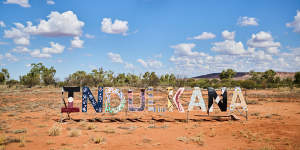
Indulkana’s Hollywood-style sign,decorated with Indigenous motifs.Rohan Thomson
Iwantja is one of seven art centres spread through the vast APY Lands that are members of the APY Art Centre Collective (APYACC). The Anangu Pitjantjatjara Yankunytjatjara Lands,to give them their full name,extend across about 100,000 square kilometres in the far north-west of SA,an area 50 per cent bigger than Tasmania. Over the past 20 years,art from the APY Lands has been surging in reputation,a creative boom that the late art dealer Tim Klingender,one of Australia’s foremost experts in Indigenous art,described to me as part of a “second wave of desert painting”,the first wave having emerged at Papunya in the Western Desert in the 1970s.
More than 500 artists live on the APY Lands and their work ranges from the boldly contemporary,such as Vincent Namatjira’s joyously wonky and subversive portraits,to the vast collaborative canvases of the five Ken sisters,winners of the 2016 Wynne Prize,and the rippling,intriguingly-hued paintings of Tuppy Goodwin,who in 2022 became the first woman to win the $100,000 Hadley’s Art Prize for Australian landscape. This year’s Hadley’s prize was again won by an APY Lands artist,Vicki Cullinan,a longstanding director of the APYACC.
We had travelled to Iwantja and the neighbouring Mimili Maku Arts centre,about an hour’s drive further north-west,at the invitation of the National Gallery of Australia (NGA) prior to its major winter exhibition,Ngura Pulka (Epic Country). The exhibition had been set to open on June 1 and feature 28 large canvases by APYACC artists.Good Weekend did not accept the invitation lightly;it’s not possible to enter the APY Lands without a permit,a police check and a suitable reason for visiting. We wanted to see for ourselves the communities riding the crest of a wave – to find out what it was that had made them so successful.
Over the past six years,that success has been rapid and dizzying. Since being founded in 2017,the APYACC has sold works to the NGA and to major state galleries,including the Art Gallery of South Australia and the Art Gallery of NSW,to private collectors both here and overseas,and to Switzerland’s prestigious Fondation Opale art centre. It has forged partnerships with the top end of town,including the Westpac Foundation,construction company Lendlease and law firm MinterEllison as well as with state and federal governments,most significantly securing a $2.5 million federal government grant for its new Adelaide headquarters,which opened in February. In an unusual move,it has also opened its own capital city galleries – in Sydney,Melbourne and Adelaide – as well as selling through other commercial galleries and its own online portal. Its fame was so widespread that,during Barack and Michelle Obama’s March trip to Australia,the couple visited the APY Gallery in Melbourne’s Docklands.
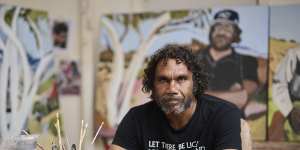
Vincent Namatjira,the first Indigenous Archibald Prize winner,in the township’s Iwantja Arts centre.Rohan Thomson
Little did we know that within a week of our visit to Indulkana and Mimili,the APYACC would become embroiled in the biggest controversy to rattle the Australian art scene in years,with allegations raised inThe Australian that white studio assistants weren’t just helping artists prepare their canvases but making decisions about composition,and painting shapes onto canvases. There were allegations,too,of white studio assistants painting on the work of Indigenous artists in their absence. Those making the allegations included some artists and staff who’d formerly worked at the APYACC or one of its art centres. The APYACC vigorously denied any wrongdoing.
Within three weeks,the NGA had announced it would review itsNgura Pulka exhibition. Three weeks later,the SA government,in partnership with the Northern Territory and federal governments,had announced its own review into the management of the APYACC. On June 7,the NGA put the.
An epic cloud now loomed over the APYACC’s achievements,threatening to engulf the entire landscape of remote Indigenous-owned art centres,generally considered the most ethical places from which to source Indigenous art. The story I’d planned to write had dissolved in the face of a 50-second video.
Like most people,when I first saw the video I was shocked,having just spent three exhilarating days on the APY Lands,meeting artist after artist who spoke of the importance of their culture,their law,their desire to pass on their skills and stories to the next generation,and to present their work to the world.
The video,filmed secretly on a smartphone at the Tjala Arts centre in Amata,one of the APY Lands communities,features artist Yaritji Young,a senior law woman and the oldest of the Ken sisters. In the corner of the video,Young bends over a canvas,laying down thick undulating lines of burgundy-coloured paint. Also in the frame are two young white assistants,who hover industriously over the canvas. “Could it do with another rock-hole there or is that going to be too circular?” one asks before the other woman,centre manager Rosie Palmer,decides that “a bit of space is probably good,a bit of space for breathing.” Palmer then asks,“Can I juice this one up a bit?” before dipping her brush into a paint-filled bucket and slapping a fresh layer of paint over a circle representing a rock-hole. “Do you want a bit of watering can on that?” the other assistant asks,referring to a method of diluting the paint to create a watery background wash.
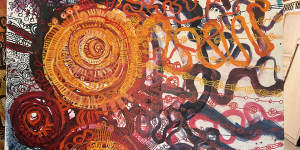
The Yaritji Young painting that was the subject of the secretly filmed video that triggered the controversy,here as a finished version with washes covered over.Supplied
The video seemed irrefutable proof that white studio assistants were overstepping their role,but also raised broader philosophical and ethical questions. Whatshould the role of assistants,long used by everyone from Michelangelo and Rembrandt to Jeff Koons and Patricia Piccinini,be in remote Indigenous art centres? What is not okay and why – and who gets to decide? What role had competition with other art centres,jealousy at the APYACC’s success and the schism between Indigenous-owned art centres and white independent operators played in all this? Had the APYACC been too ambitious,too aggressive and cut too many corners in the way it went about things?
For months,Yaritji Young has kept her silence,bruised by commentary questioning the authenticity of her work. I first met Yaritji and her husband Frank Young,a senior lawman and skilled maker of spears,during my March trip,before her world was turned upside-down. Many months later,Yaritji agreed to speak toGood Weekend via Zoom about the circumstances of that video. Frank sat alongside her,while fellow artist Sally Scales,from a younger generation and fluent in English and Pitjantjatjara,translated via Zoom from her home in Adelaide. Even across the screen,Yaritji’s anger was palpable. “I am angry about it but I’m also sad about it,because I was not doing anything wrong,” Yaritji said.
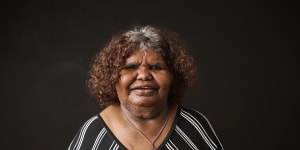
Yaritji Young,who rejects any suggestion she’s been told what to paint.Rohan Thomson
Yaritji,who is in her late 60s and has physical disabilities,has been painting for 15 years. She explained that multiple layers of paint are applied to her canvas and that the assistants were helping her apply the first layer,the background. She told me she teaches her assistants how to work with her and has done so with the various individuals who have worked at Tjala Arts over the years. I ask whether white people ever told her what to paint in her artworks. “No,” she said. “I do it myself,in my way … that is my painting,that is my canvas. They know what to do because I have taught them what I need and how I want to work. If they can’t help me,that’s fine,I’ll use a big broomstick to reach the middle spots[on the canvas].”
One of the most troubling aspects of the video is the assistants discussing the placement of rock-holes. Their actions appear to contradict the idea that a painting embodies an artist’sTjukurpa – a Pitjantjatjara word with no direct English equivalent that is often simplified to “Dreaming”.
Yaritji said she was upset by suggestions herTjukurpa had been usurped by her white helpers. “Having artistic support doesn’t take away myTjukurpa,” she said. “MyTjukurpa is in the manta[ground/earth],it’s in theinma[ceremony,song,dance],it’s in the songline,it’s in all of it,there’s not just one dimension or one thing that has ourTjukurpa.”
“I am angry about it but I’m also sad about it,because I was not doing anything wrong.”
Yaritji Young,artist
She is cross that those who have criticised her did not come to her with their grievances before going to the media. “I am inviting those who are saying that what we are doing is wrong to come and speak with me,with the elders,and with the senior people in the community,particularly the other Indigenous people who are making these comments without talking to me. I am a strong Anangu woman. I live on my Country. I know my language,my culture,and sacred sites. No one should be talking about me without coming to speak to me. Who are they to do that?”
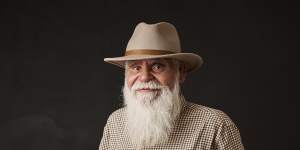
Yaritji Young’s husband Frank Young,a senior law man.Rohan Thomson
Many Western artists direct others to produce their artworks,yet rarely does anyone question their right to be named creators of that work. So what are the expectations on Indigenous artists – and where should the line be drawn? The questions are complex because although remote community art centres are Indigenous-owned,the art managers and advisers are often white,acting as conduits between two distinct worlds,and between the desires of the market – and its mostly white buyers – and the needs of artists,who vary widely in age and ability. As the Indigenous artist and activist Richard Bell famously put it in the title of his landmark 2002 essayBell’s Theorem:“Aboriginal art – it’s a white thing.”
Certainly,white people have been there since the start of the contemporary Indigenous art movement,when a sensitive young art teacher,Geoffrey Bardon,encouraged the senior men of the Papunya settlement in central Australia to transfer their ritual designs onto board using acrylic paint. Decades before that 1970s movement,the white artist Rex Battarbee introduced Albert Namatjira to a European style of landscape painting.
Philip Batty,former senior curator of Melbourne Museum’s Central Australia Indigenous cultures program,points to the more recent rise of Hermannsburg pottery,which was never an Arrernte tradition,and to figures stuffed with spinifex grass,again a non-traditional form. “In recent times,there’s been any number of ‘new’ Aboriginal art forms inspired and heavily facilitated by white art advisers,” Batty tells me via email. “I don’t have a problem with any of this. All forms of art are to some degree ‘hybrid’.” Batty says he’s seen many white art advisers “shaping” the work of Aboriginal artists. “This included restricting the kind of colours the artists can use,telling artists to paint in a certain style,repeating paintings that sell,getting artists to work with new forms.” But,he says,“I have never come across a white ‘assistant’ actually applying paint to an Aboriginal artist’s work. That really is going too far.”
“No one would ever question a white artist for having any assistant,no matter what race or ethnicity that they are.”
Tony Albert,Indigenous artist
Indigenous artist Tony Albert,a founding member of the Brisbane-based collective ProppaNOW,offers a different perspective. “No one would ever question a white artist for having any assistant,no matter what race or ethnicity that they are,so the fact that an Aboriginal person can’t utilise that within the context of a studio and making work I think is really ridiculous,particularly in the context of contemporary art … The only people who should be saying whether it’s right or wrong are the people who are making the work,and if they say it’s their art,it’s their art.”
Despite the complexities of their role,art centre assistants tend to learn on the job and from the Indigenous artists with whom they work. There are no set protocols,and ways of working differ from art centre to art centre. Two former managers,who did not want to be named,told me they’d grappled with the nature of that cross-cultural engagement from day one. One told me it was all too easy for an outsider to misconstrue the relationship between studio assistant and artist. “Working with artists is a really delicate process,” she said. “It’s common for outsiders to come in and be there for a moment and not understand what’s going on.”
Prepping canvases,stretching them,priming them and laying down background paint was common and acceptable assistance in the centres where they’d worked (not APYACC centres). So,too,were discussions about colour palettes and composition. Giving feedback and critiquing artworks was also totally acceptable. But painting over a rock-hole? “Actually painting rock-holes on canvas? My gut feeling is that it sounds really wrong. It’s not what I would do,” one of them said.
The production and sale of Indigenous art is a multifaceted arena with competing economic systems at work. At one end are the remote community art centres,not-for-profit organisations that are Indigenous-owned and governed. There are about 100 of these across Australia and they’re the bedrock of Indigenous art production,nurturing and developing artists. These centres are subject to yearly public audits,their financial statements available online,and the majority of the income they generate is returned to the artists and art centre businesses. They play a fundamental role in the wellbeing of remote Indigenous communities,where people often live on the poverty line and jobs are scarce or non-existent. Making art is often the only source of non-government income and a huge source of pride,a way of maintaining culture. At the other end of the spectrum are independent operators,who often entice the best artists away from Indigenous-owned art centres to paint for them on terms that are not always clear.
This fraught and competitive sector has been the focus of several government inquiries,most notably a 2006-07 Senate inquiry that looked into the integrity of artworks sold commercially and the conditions under which they’re produced and traded. That inquiry noted that “carpetbagging has been recognised by almost all the submissions as one of the major problems confronting the Indigenous visual arts industry today”. It defined a carpetbagger as a person who “is usually not Indigenous and seeks to obtain art from an artist at a price well below what that person knows or ought to know is a reasonable market price,with the intention of selling it on for a substantial profit”. Carpetbaggers often pay artists in cash,cars,drugs or alcohol. Unethical dealers have been known to lend money to members of an artist’s family – with the artist then induced to produce paintings in order to free the family member of debt. But not all private operators are unethical and some artists prefer to work as free agents,or to move between art centres and private painting sheds where they may receive cash or other payment.
While the APYACC remains not-for-profit,its business model is unusual. Typically,art centres in remote Indigenous communities sell through existing commercial galleries. But the group also sells through its own galleries,returning 80 per cent of an artwork’s retail price to its remote community art centres,compared with the general industry standard of 50-60 per cent. It also actively seeks opportunities to exhibit work in public galleries – theNgura Pulka exhibition,for example,was not commissioned by the NGA. Rather,it was a community-driven project,with the APYACC taking the initiative to find an exhibition partner. Last financial year,it reported revenue of $8.4 million;more than half – $5 million – was from art sales,with the rest mostly from government and philanthropic grants to help fund infrastructure,art projects and operational expenses. Of that $5 million in sales,$3.9 million was returned to its member artists and art centres.
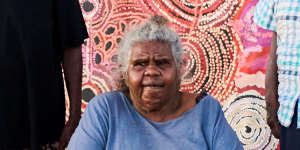
Maringka Burton,Tuppy Goodwin,Sylvia Ken,Betty Muffler,Iluwanti Ken,Betty Chimney,Puna Yanima and Betty Pumani with their painting that was set for the NGA’s Ngura Pulka exhibition.Rohan Thomson
The APYACC is also unusual in that it owns property – its Adelaide headquarters is a former plaster showroom,bought for $2.9 million in 2022 with the help of a $2.5 million federal government grant. The group took out a commercial loan to cover the rest.
“It’s the biggest thing that’s happened to our organisation in terms of collective confidence and being empowered to continue with a big,ambitious dream … the building is a vital piece of that,” general manager Skye O’Meara told me when I visited in February for the announcement ofNgura Pulka,an event attended by supporters including former SA premier Steven Marshall and NGA director Nick Mitzevich.
The building incorporates offices,a gallery and a studio,which is used as a home away from home by artists travelling to the city,and by younger Adelaide-based APY artists such as Sally Scales,Zaachariaha Fielding and Alfred Lowe.
Interestingly,what O’Meara has done in Adelaide is what the 2007 Senate inquiry recommended for Alice Springs:that is,create an art centre that would cater for Indigenous artists visiting town from surrounding settlements and protecting them from the approaches of unscrupulous operators.
The APYACC’s success has prompted Indigenous communities beyond the APY Lands to sign up,such as Coober Pedy,which joined the group in 2020 and set up Umoona Arts. George Cooley,a director of Umoona,told me the community had been wanting a fully fledged art centre for years and never found an organisation capable of delivering one until the APYACC came along. “We’ve had more support in three years from the APYACC than the last 30 years[from other organisations] … it goes further than just the art centre;it’s about getting artists recognised.“
But the APYACC’s entrepreneurial drive has created tensions with both independent operators and other Aboriginal artists and art centres. Those critical of the APYACC argue that it’s been driven too hard,and that its success has led it to favour commerce over culture.
APYACC general manager Skye O’Meara provokes strong reactions – “irrepressible”,“volcanic”,“bright” and “polarising” are some of the words used to describe her. Born in Sydney,the 48-year-old grew up in the Blue Mountains in a middle-class family. She studied visual arts at the Canberra School of Art and started working in remote Indigenous art centres in her early 30s as manager of Tjala Arts. She was at Tjala for a decade before helping Anangu elders set up the APYACC in 2017.
Remote art centre managers suffer from high rates of burnout. There’s the need to be everything from art adviser to accountant to social worker and more,while working in isolated and extreme conditions. It’s rare for people to last in the job for more than 10 years. Two to five years is the norm;six months is not uncommon. O’Meara has been at it now for 16 years. “Like lots of young people,I went out there for the adventure and stayed once I had an understanding about how impactful art centres could be,” she says. “I absolutely know the benefit of an independent income,especially for women.”
O’Meara has been a fierce opponent of independent operators. In 2019,in a particularly bold move,she sent a letter to the chairs of Telstra and the Museum and Art Gallery of the Northern Territory (MAGNT) complaining that certain independent operators had been invited to the 2019 Telstra National Aboriginal&Torres Strait Islander Art Awards and that this had left artists feeling “deeply disappointed,hurt and disrespected”. That letter was signed by 61 of the APYACC’s most prominent artists,Vincent Namatjira among them. Namatjira tellsGood Weekend that he signed the letter to support his mob and to stop Aboriginal artists being taken advantage of. Some of the independent operators named in the letter have been among those criticising the APYACC.
“Skye has the full support of the board … We don’t need other people to come in and tell us what to do.”
George Cooley,an Indigenous director at APYACC
In the face of the SA government review and a highly personal media campaign against her,I ask O’Meara if she has thought about temporarily stepping down. She tells me she’s considered it but that “my directors are adamant that I need to stay”.
APY artist George Cooley,one of the APYACC’s Indigenous directors,says the board does not want O’Meara to step down. “Skye has the full support of the board,and so do the other white staff here,” says Cooley. “We don’t need other people to come in and tell us what to do. The board is capable of making its own decisions. Others may have a problem with Skye,but we don’t. Out of all the panic you have three governments reviewing us,with us scratching our heads,wondering,‘What are you really reviewing and on whose behalf?’ “
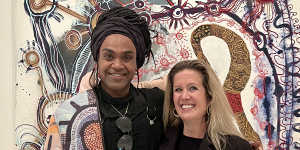
Wynne Prize winner Zaachariaha Fielding (left) and APYACC general manager Skye O’Meara,in front of his Untitled 2020 painting at the National Gallery of Victoria. Supplied
I ask O’Meara how she sees that contentious video. “Yaritji Young has had support from her studio staff over her 15 years of practice in a similar way and it has always been restricted to the wash or the canvas,which we consider to be the canvas prep. She has a broken bone in her neck that has not been sorted to her satisfaction,and this was a two-by-three-metre canvas. It’s the role of studio assistants to operate under the direction of the artist. And that video was made to look ugly and there is nothing ugly about the role of studio assistants in remote community art centres.”
In the wake of the allegations made against it,the APYACC went from success story to pariah. Exhibitions of APY Lands artists lined up in Europe and the United States were put on hold,and collectors and clients started calling art centres and galleries,demanding documents such as statutory declarations or photographs of artists standing in front of artworks as proof that the paintings they’d bought,including works acquired years ago,were indeed made by the artists named. “It does appear that the allegations are impacting sales and artists’ income,which is so important to artists and their families,” says Iwantja Arts manager,Beth Conway. “I think it’s created a level of distrust in remote art centres,which is incredibly sad when art centres make such a powerful change in the community.“
The APYACC’s funding has also been hit. The SA government has cut operational support of $280,000 a year,with state arts minister Andrea Michaels calling for Skye O’Meara to stand down pending the outcome of the state review. The APYACC has also lost $90,000 in annual funding from the federal Indigenous Visual Arts Industry Support (IVAIS) program. In a letter to the group,IVAIS director Samantha Browne cited the pending review and media allegations as reasons for the decision. Peak bodies such as Desart,which represents central Australian Aboriginal art centres,have also distanced themselves.
As an organisation,the Indigenous Art Code (IAC) isn’t known for being particularly tough on unethical behaviour (in 2019,former minister for Indigenous Australians Ken Wyatt criticised its failure to protect vulnerable Indigenous artists from disreputable private dealers). But the IAC took the unprecedented step of terminating the APYACC’s membership – the first time in its 14-year history that it’s taken such action.
Following the IAC’s move,MAGNT director Adam Worrall barred the APYACC from entering its artists in this year’s National Aboriginal and Torres Strait Islander Art Awards,the most prestigious on the Indigenous arts calendar. In response,APYACC chair Sandra Pumani wrote to Worrall expressing her dismay that he’d “excluded us,hurt and disrespected us without even picking up the telephone to see our version of events which strongly disputes what you read in the newspaper”.
Worrall responded that “MAGNT would not accept or tolerate any agent or art centre where evidence of intimidation,coercion or unethical treatment is involved.” This prompted further letters to him from Zaachariaha Fielding and Sally Scales,with Scales writing,“The fact that you believe that I would allow my elders to be so badly mistreated in our company is deeply offensive and sad to me.”
Art dealer Beverly Knight,of Melbourne’s Alcaston Gallery,who has fostered the careers of many Indigenous artists and represents Yaritji Young and other prominent APY artists,says she too thinks O’Meara should step down pending the outcome of the SA review. “There needs to be a circuit-breaker,” she says. Knight also expresses disquiet about the high volume of work coming out of the APYACC’s Adelaide studio:“I’d made my concerns known to the APY art centres about the marketing and supply from the APY collective and that was last year.”
Yet other public and commercial galleries continue to stand by the APYACC. Respected Brisbane gallerist Jan Murphy is showing the work of Iluwanti Ken and Betty Muffler at Sydney Contemporary next week. “Skye O’Meara has always demonstrated the utmost professionalism in my dealings with her,” Murphy tellsGood Weekend. International art agent Matthias Arndt is going ahead with an exhibition of APY Lands artists at the GNYP Gallery in Berlin this month following what he describes as the “liberating” results of the NGA’s report (more on that shortly),and exhibitions in Athens and Berlin that had been planned for Zaachariaha Fielding – winner of this year’s Wynne Prize at the Art Gallery of NSW – are also back on track.
Fielding,who first found fame as the singer in the electronic pop duo Electric Fields,is angry about the way O’Meara has been depicted. “Skye is not the boss,she works for us,” he tellsGood Weekend. “Skye is driven by our board … and it’s really interesting seeing her being painted out as this white bossy woman,bossing Anangu,and it’s never been the case. If anything,I feel sorry for her when she does get bossed around by the board.”
In early August,after an almost three-month investigation that entailed interviewing 29 artists and 10 current and former studio workers,the NGA wound up its review,its panel reporting that the 28 paintings destined for the gallery’s walls met its “provenance standards”.
The inquiry was headed by two lawyers,Melbourne barrister Colin Golvan and Sydney-based special counsel Shane Simpson,who were assisted by two Indigenous experts,Bidjara woman Maree Meredith,the University of Canberra’s Pro Vice-Chancellor Indigenous Leadership,and Kokatha and Nukunu woman Yhonnie Scarce,an artist. Their 34-page report concluded that,“Without exception,the artists to whom we spoke unequivocally told us that the works under review in each case were made by them and expressly denied that there had been any improper interference in the making of their work.” It added:“We strongly reject any implicit or actual suggestion that the artists have been engaged in any cover-up,abandonment of their cultural obligations or dishonest practice by making false claims of authorship in the paintings. It has no proper foundation.”
As to what help an artist should and should not receive in creating an artwork,the report said that if an artist remains in “effective creative control” of the work being made,then the work is authentic. The line is crossed,says the report,when an assistant or studio worker “takes control” of a painting rather than just offering advice or direction. It’s a fine line,one that will continue to be debated.
“As the report states,you’ve got to start with an assumption that the artist is telling the truth.”
Ian McDonald,special counsel
Ian McDonald,from Sydney law firm Simpsons,one of two special counsels who did the fact-finding for the NGA review,tellsGood Weekend that all those who had made allegations against the APYACC had been encouraged to come forward,but not everyone did. Of those who were interviewed,including former artists and art centre workers,only one,a former art centre worker,gave sworn testimony. However,after the review team had spoken with her three times,her story buckled. She had been adamant,for example,that she’d seen a painting created in the Adelaide studio mostly by white staff while the Indigenous artist sat watching. But the woman had not been working at the APYACC on the days the painting had been created (which she then acknowledged) and the team was not able to identify any other painting created by the Indigenous artist that matched her description. The same woman also claimed a painting was finished by white studio assistants on certain days of the week in the run-up to the Bangkok Biennale,but date-stamped photographs showed the painting had been finished long before the biennale due-date and on different days of the week.
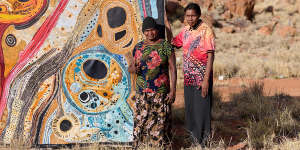
Pauline Wangin,Betty Campbell and Emma Singer,also at Mimili,with their work for the NGA’s Ngura Pulka exhibition.Rohan Thomson
The team also spoke to academic commentators and Aboriginal corporations,including Desart,Ku Arts,the Indigenous Art Code and Ernabella Arts,which is located on the APY Lands but has publicly disassociated itself from the APYACC. The information provided by these groups and individuals was too general to be relevant to the investigation,which was limited to the 28 paintings in theNgura Pulka exhibition. Ironically,the painting at the centre of the controversial video was never part ofNgura Pulka,and was therefore outside the NGA review’s terms of reference. Nevertheless,the review team said it had received credible information from several sources about the “full context in which the actions captured in the video took place” and that this brief,edited video needed to be interpreted with care. The review team was unable to obtain an unedited version of the clip.
The APYACC’s critics questioned the independence of the review,flagging the close relationship between the NGA and the APYACC,and the investigation’s
narrow scope. McDonald rejects that criticism. “As the report states,you’ve got to start with an assumption that the artist is telling the truth. If you’re going to then say that they’re lying,you really need strong counter-evidence,but the counter- evidence presented to the reviewers just simply didn’t stand up,” he tellsGood Weekend. “It’s quite an extraordinary proposition that a number of young white women would be producing so many of what are seen as the best Aboriginal paintings in Australia today. This notion is,in any case,completely counter to the way the reviewers found the power relationships at work,particularly in the art centres on Country but also in the collective’s Adelaide studio. The artists were clearly in charge. As the reviewers found,the artists are strong cultural custodians,and highly protective of theirTjukurpa.”
The report cleared the way for theNgura Pulka exhibition to go ahead,but that won’t be this year since it has now missed its slot in a packed annual calendar. NGA director Nick Mitzevich would not be drawn on a timeframe but said,“We are working closely with the artists and will make programming decisions in due course.”
According to O’Meara,when the APYACC’s artists and art centre staff learnt via video-link that the paintings created forNgura Pulka had been exonerated,there were tears of joy and relief,singing,hugs and prayers. “It was a really emotional meeting,the atmosphere was electric,” she says. Then came the inevitable question:“Is this over now?“
Not yet. The extensive tri-government review led by South Australia is just getting started and will be conducted by Adelaide lawyer Anne Sibree,Menang woman Megan Krakouer,the director of the National Suicide Prevention and Trauma Recovery Project,and Quandamooka man Cameron Costello,the deputy chair of the Queensland Tourism Industry Council. That broader investigation will address “current and historical” allegations that the APYACC’s staff interfered with the work of Indigenous artists,and that management did not support a “culturally safe,respectful and appropriate workplace”. A South Australian government spokeswoman tellsGood Weekend that they hope to have findings by the end of the year after a thorough investigation.
“Bring it on,” an emboldened O’Meara tellsGood Weekend. “We’re really looking forward to the South Australian review so these allegations can be tested and debunked as well.“
As for the APYACC’s artists,they’re still making work,selling work,exhibiting work,being nominated for prizes,winning prizes. “We are strong people,” says Frank Young. “We are not going to give up.”
Gabriella Coslovich travelled to the APY Lands with assistance from the National Gallery of Australia.
To read more from Good Weekendmagazine,visit our page at, and
